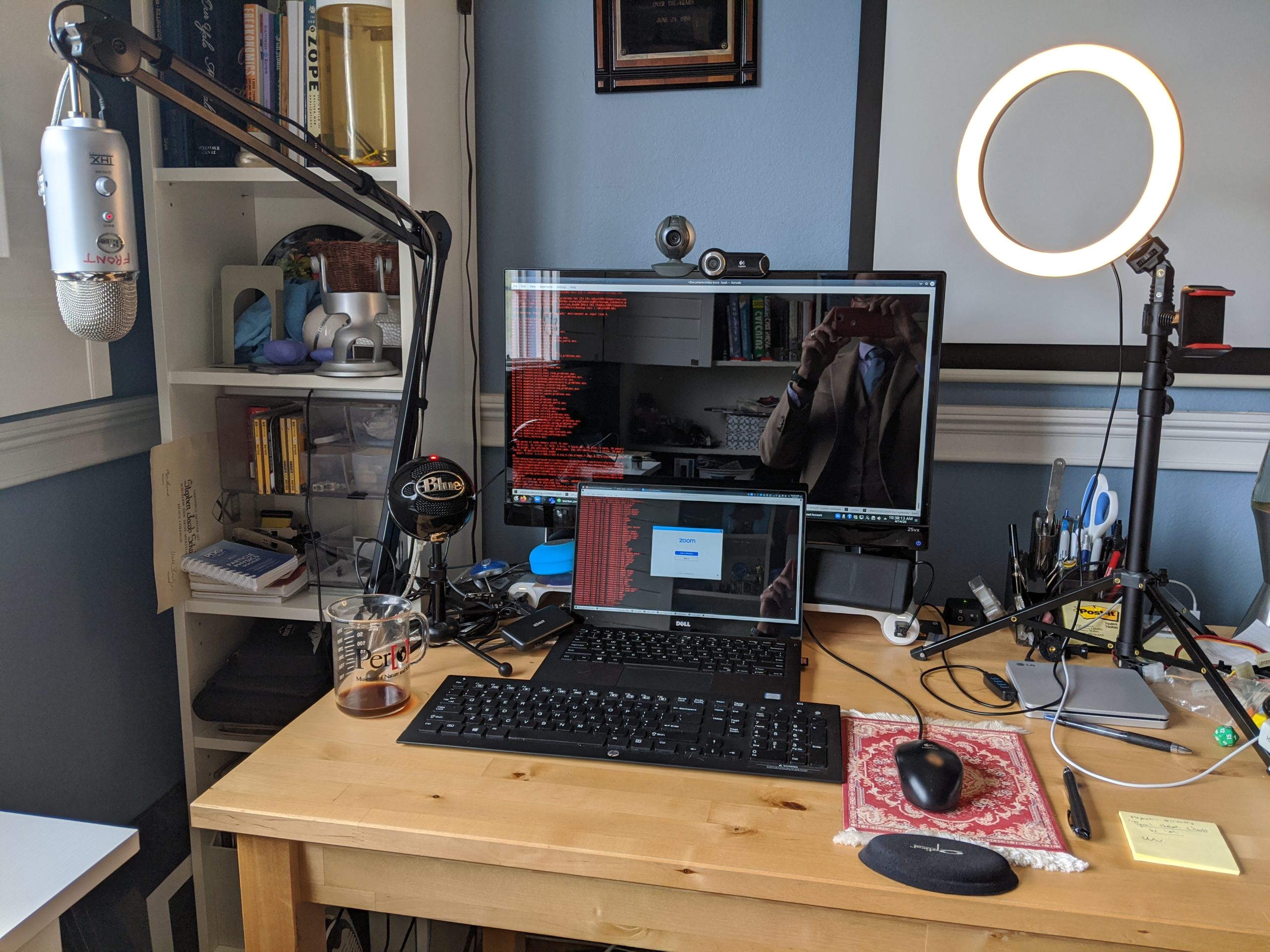COVID-19 is stressing systems in interesting ways. One thing we are seeing with increasing frequency in the U.S. is schools switching to “online teaching” for the next several weeks (perhaps even for the rest of the terms this academic year). Below, I share some of my perspectives on strategies for “online teaching” – or, more accurately, what I would frame as “digital teaching.”
Prologue: Snow Days
Back in about 2010, after Jodi and I had just started at SMU, it snowed in Dallas. To be more accurate, there was significant precipitation combined with plunging temperature. This resulted in a flash freeze of the moisture on the ground, followed by snowfall. Temperatures remained below freezing for a couple of days. Since there is limited infrastructure in Dallas for ice and snow mitigation, the city effectively shut down. After announcing at night that they would not cancel classes (more accurately, SMU announced that students were not required to come to class but faculty still had to show up to teach), very early the next morning the University canceled all classes. This went on for two days.
Classes might be canceled, but you can’t lose two days in a 15-week semester. That’s too much information to be sacrificed, especially in introductory physics classes like those often taught by junior faculty. Jodi and I started recording lecture videos and holding office hours and discussions online. At the time, it was basic screen recording with a microphone (for lecture videos) and a private physics BigBlueButton server we were running at SMU that did the trick. These events laid the foundation for Jodi and I to be ready for the current COVID-19 pandemic.
Of course, a few years later Jodi and I would transform our teaching styles, “flipping” our classrooms (read and watch the lecture video before coming to class, and use class to exercise new material instead of lecture). The lessons learned during those snow days would lead to online lecture videos for our courses, wider use of digital teaching technology (basic web pages, online homework delivery systems, whole teaching management systems, etc.).
My Current Digital Teaching

“Digital teaching” is merely a style of teaching I practice that combines the efficiency of information transfer from face-to-face interactions with digital platforms for delivering, grading, and returning learning materials. Here is a snapshot of my current third-semester physics course (“Modern Physics”), which is typical of how I run a college class of any kind. I use Canvas LMS as the backbone of our course delivery, as it seamlessly turns assignments into calendar data to provide a clear stream of expectations for students, especially deadlines.
- Pre-Class Quizzing
- Students have access to a brief spot-check quiz within 24 hours of a class period. It checks that they did the bare minimum: read the textbook and watched the lecture video. To encourage students to really take those activities seriously, students are asked to treat reading and the video as if they were in-class with a professor: take notes, pay attention. Of course, video is better: they can speed it up, or pause it if they get stuck on something. The quiz is 5 minutes long, 3 questions (multiple choice), and all together these are worth 10% of their final grade. I deploy these using the Canvas LMS.

- Students have access to a brief spot-check quiz within 24 hours of a class period. It checks that they did the bare minimum: read the textbook and watched the lecture video. To encourage students to really take those activities seriously, students are asked to treat reading and the video as if they were in-class with a professor: take notes, pay attention. Of course, video is better: they can speed it up, or pause it if they get stuck on something. The quiz is 5 minutes long, 3 questions (multiple choice), and all together these are worth 10% of their final grade. I deploy these using the Canvas LMS.
- Homework
- A mixture of textbook problems and problems I write from scratch, these are assigned every week (every two weeks when an exam intervenes). They are deployed as a PDF file listing the book problems and with the full text of my custom problems. Students are to submit a scan of their full work using the Canvas LMS. I then grade these using a basic and general rubric and return the assignments, with comments, digitally on Canvas. I can use my iPad to load the assignments in the Canvas Teacher App, mark them up with my Apple Pencil, write typed comments, and grade using the embedded rubric that accompanies the homework assignments. I don’t score each problem; I mark up each problem and give them an overall grade. Did they demonstrate complete, strong, fair, weak, or poor overall mastery of concepts and problem-solving? Did they get all, most, many, some, few, or no problems correct? Did they follow my class policy on written assignment quality? For learning weaknesses, I provide written summary comments asking them to review or focus on certain things, and to meet with me if needed. Homework is 15% of their final grade.
- Exams
- These I do in-class, but if I ever have to move them online this is where I am absolutely weakest. However, I have strategies in mind: keep the exams timed, but deploy a random set of problems to each student. Use screen-focus technologies in Canvas to prevent them from switching the focus on the device they are using to take the test. Assume they have access to external information, so write problems from scratch (I use Jupyter notebooks anyway for this, so inputs to problems can be easily changed to get new answers). There are ways to deal with this if ever I have to go online. I write exams so that a student with full or strong mastery of the material can complete the exam after 60% of the allotted time has past, allowing time to review solutions. It doesn’t take many problems to identify weaknesses and strengths in a student. Exams are worth 50% of the final grade, including the comprehensive final exam.
- The Grand Challenge Problem
- This is a team-based exercise where students are given a prompt and develop actual research questions from the prompt, then go into detail on those questions. I’ve already moved a lot of this to digital. Canvas LMS provides digital message board for teams, and the teams are easily organized through Canvas in the first place. Monitoring the online discussion is the most challenging part for me; for some weird reason, when you have discussion forums split over multiple teams, the instructor is not notified when students post in those split forums. For a dedicated forum (one that the whole class uses), I get notified when a student posts; but not for these. The final product are presentations from each member of the team on their contribution(s) to answering the research questions. These can be easily provides as videos, if necessary. This activity is 20% of the final grade.
- Participation and Attendance
- A student gets a 1/1 for attending class. If they also participate in in-class activities and get correct answers for those activities, I add 0.01 point for each correct answer. Yes, it’s possible to exceed 100% in this part of the course, but that’s the nature of incentives. I find students typically don’t earn more than 50% of the extra points above 100% This is worth 5% of the final grade, so although they can exceed 100% in this is doesn’t have a large effect on the final grade, except to guarantee participation which is the foundation of success.

- A student gets a 1/1 for attending class. If they also participate in in-class activities and get correct answers for those activities, I add 0.01 point for each correct answer. Yes, it’s possible to exceed 100% in this part of the course, but that’s the nature of incentives. I find students typically don’t earn more than 50% of the extra points above 100% This is worth 5% of the final grade, so although they can exceed 100% in this is doesn’t have a large effect on the final grade, except to guarantee participation which is the foundation of success.
What if I have to go all-digital to deal thanks to COVID-19?
80% of my course is “digitized” already. The two main areas where digitization needs to be deployed are:
- Exams: as I said above, I’ve never tried to deploy exams digitally. This will be where my energy most needs to be spent. The strategy I will take is “less is more” – assume students will have access to external resources; generate unique content for the exam; dole out portions of that to students in random allotments (not all students will see the same problems). How they provide their answers and evidence of their work are, for me, the most difficult questions.
- Interactions: Zoom, which is the digital communications platform available at SMU, works great. However, I’ve never tried to use it to run a classroom. Mine is small – only about 11 students. But other classes have 50 or 150 students in them. That is more challenging. Since I use class time for interactions, I should be able to preserve that through Zoom. For a regular lecture-only class, I’d just move it all to online lecture video and eliminate class time; use a quiz to check students on whether they are keeping up with lecture material, and have office hours online where students can ask questions and get help.





